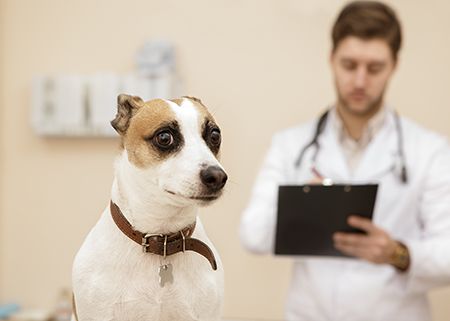Skittish dogs: Tips, client handout for veterinary team members
Behavior specialist Anthony De Marinis shares actionable advice for veterinary teams and their clients when it comes to calming nervous patients.

(Nestor/stock.adobe.com)
What do you need to do to help dogs who show up frightened by a visit to your veterinary hospital? Behavior specialist Anthony De Marinis has a few actionable tips-and a free client handout!-to help you make even the most nervous of patient visits successful and calm.
Know what you're looking at
Develop a basic understanding of the animal's emotional state through their behavior and body language. If you know what to look for in a nervous pet, you'll have a better chance of trying to help address it in a more proactive and positive way.
Take a Fear Free or other calm-handling certification course
This will definitely set you up for success to provide patients with a less stressful experience. (Learn more about low-stress tips here.)
Ask questions about triggers for fear, anxiety and stress
If veterinarians, veterinary technicians or veterinary assistants ask at the beginning, pet owners will share. Include these notes in the patient's record, so no matter who's working that day, everyone will know how to handle that particular patient.
Meet patients in the waiting room with treats
Food-motivated dogs love high-value treats. Positive reinforcement trainers and behavior professionals typically use a value system with the types of treats that are used. For example, rather than using a boring Milk-Bone biscuit, I like Freshpet Nuggets, pieces of chicken breast, frozen diced ham, frozen baby shrimp, spray cheese, whipped cream or a particularly tasty brand of canned dog food. (Frozen suggestions above can be placed in a microwave to thaw out-don't heat enough to cook-as it may be more enticing to dogs.)
Use pheromones
Products like Adaptil plug-in diffusers in the waiting room and exam rooms can lower patients' stress levels. Using these products in spray form and spraying them on staff scrubs can also help.
Throw a treat party in the exam room
Do this where the dog feels most comfortable. If that means the floor, use the exam room floor rather than having your nervous patient elevated on the table.
So, you can do everything above and still have a frightened canine patient. Creating a soothing environment requires help from everyone involved, including clients. Click here to download a printable version of the client handout “How to soothe anxious dogs at home and at the veterinarian.”

Anthony De Marinis, CDBC, VSPDT, CBATI, VSA- DT, TTWC, is a certified dog behavior consultant and certified Fear Free animal trainer in Long Island, New York. He can be reached at 516-582-7877 or at www.thegoldcoastdog.com.